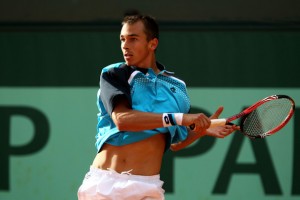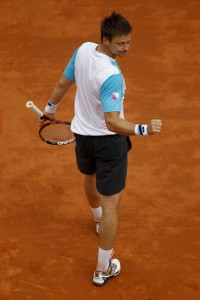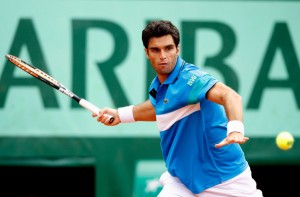French Open, Day Five
 Six qualifiers have progressed to the third round of Roland Garros: Antonio Veic, Leonardo Mayer, Lukas Rosol, Steve Darcis, Alejandro Falla and Lukasz Kubot. I’d like to say this is the first time, but honestly I haven’t checked. Six feels like a lot, though. Admittedly, if it’s going to happen anywhere, it’ll be on clay; if so inclined, a Challenger-level player might confine himself to dirt for much of the year, thereby honing some pretty specialised skills. So armed, he will occasionally inflict a bad day on peers whose higher ranking was primarily achieved on hardcourts or grass. Still, regardless of precedent or reason, six is a decent number, and rendered more striking by the fact that aside from those six, only four other non-seeds have progressed to the last 32.
Six qualifiers have progressed to the third round of Roland Garros: Antonio Veic, Leonardo Mayer, Lukas Rosol, Steve Darcis, Alejandro Falla and Lukasz Kubot. I’d like to say this is the first time, but honestly I haven’t checked. Six feels like a lot, though. Admittedly, if it’s going to happen anywhere, it’ll be on clay; if so inclined, a Challenger-level player might confine himself to dirt for much of the year, thereby honing some pretty specialised skills. So armed, he will occasionally inflict a bad day on peers whose higher ranking was primarily achieved on hardcourts or grass. Still, regardless of precedent or reason, six is a decent number, and rendered more striking by the fact that aside from those six, only four other non-seeds have progressed to the last 32.
(Q) Rosol d. (8) Melzer, 6/7 6/4 4/6 7/6 6/4
The upshot is that 22 of the initial 32 seeds remain, which as attrition goes is not excessive. Other Slams fare far worse. However, it is the calibre of the fallen seeds that has pushed brows up, and the ramifications thereof. The top ten is being reshuffled, almost hourly. Last year’s semifinalists – Berdych and Melzer – are now both out, and both to qualifiers. The gravity of the 52-week ranking system is generally irresistible. A big result or two buys a year’s buoyancy,  but once that has expired, you’d better be able to back it up, or you will return to earth in a hurry, with a thud. Melzer is in free fall. Berdych still has a Wimbledon final to defend before he too produces a sizeable crater.
but once that has expired, you’d better be able to back it up, or you will return to earth in a hurry, with a thud. Melzer is in free fall. Berdych still has a Wimbledon final to defend before he too produces a sizeable crater.
(5) Soderling d. (Q) Ramos, 6/3 6/4 6/4
This is partly why Robin Soderling ranks among the more intriguing cases in men’s tennis. Based on his efforts at the 2009 French Open – did you know he beat Nadal? – his ascent was swift, and by capitalising on some good fortune at the World Tour Finals that year he rose even higher. However, two years on, and the cheerful Swede continues to blow raspberries at precedent and gravity. His two preferred things are clearly ‘indoors’ and ‘Paris’, and he combined them to great advantage in winning the Paris Indoors last year. His portfolio of points is now sufficiently diverse that a failure to defend his final here at Roland Garros this year would be a serious blow, but not a mortal one. Those are thoughts for later, however, since Soderling is still in the draw, although he has so far only faced a lucky loser and a qualifier, with another qualifier next up. He will doubtless reach the fourth round without facing anyone in the top hundred. It’s better to be lucky than good, I suppose, although it’s ideal to be both. Speaking of Nadal . . .
(1) Nadal d. Andujar, 7/5 6/3 7/6
So far the defending champion has looked unusually vulnerable, although the more fervent zealots have suggested that this is when he is at his most dangerous. This is not only counter-intuitive, but wrong. He is always dangerous, but he is at his most dangerous when he looks dangerous. Of course, Nadal dropped a couple of sets to Isner, but he rightly rued the squandered energy more than the score. Today he was back to squandering: he won in straight sets over his compatriot Andujar, but again looked terribly unconvincing and spent far too long doing it, having to rally from 1/5 in a third set that lasted 93 minutes, which is nine minutes longer than Federer’s entire match took yesterday. The French Open is only two rounds old, and Nadal has already spent well over seven hours on court.
at his most dangerous when he looks dangerous. Of course, Nadal dropped a couple of sets to Isner, but he rightly rued the squandered energy more than the score. Today he was back to squandering: he won in straight sets over his compatriot Andujar, but again looked terribly unconvincing and spent far too long doing it, having to rally from 1/5 in a third set that lasted 93 minutes, which is nine minutes longer than Federer’s entire match took yesterday. The French Open is only two rounds old, and Nadal has already spent well over seven hours on court.
Fortunately, Nadal is close to Albert Costa, who fair bristles with useful advice. As defending champion in 2003, Costa played approximately 22 five setters on his way to the semifinals, and spent almost 7 weeks on court, although my recollections may be hazy. Nadal is drawn to meet Soderling in the quarterfinals, where he will be as exhausted as Soderling is ill-prepared.
